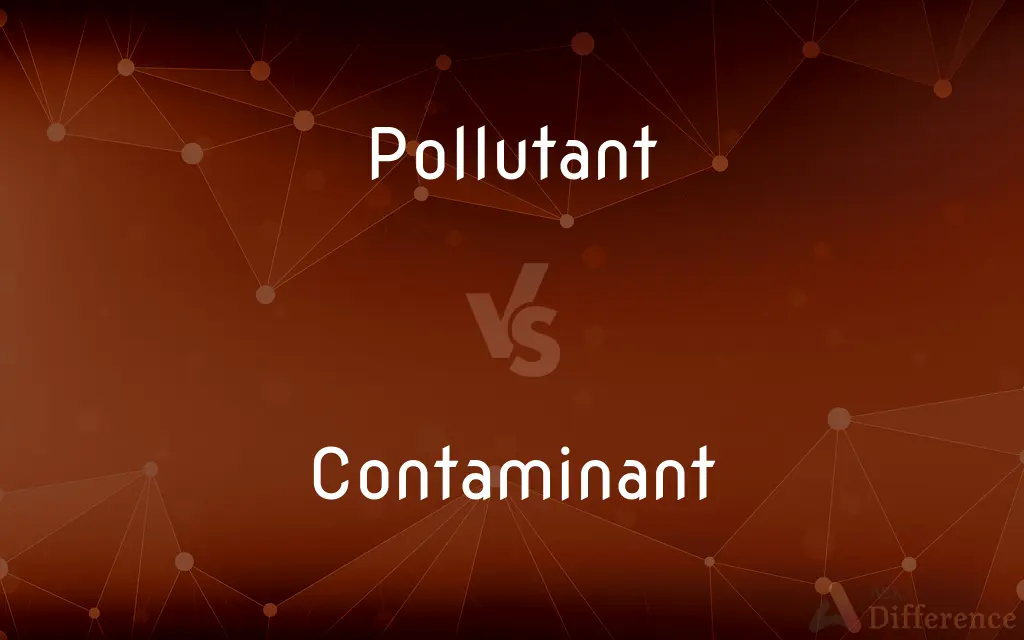Pollutant vs. Contaminant — What's the Difference?
By Fiza Rafique & Urooj Arif — Updated on April 2, 2024
A pollutant is a substance introduced into the environment that causes harm to organisms, emphasizing its damaging effects. A contaminant is any substance that makes something impure or unsuitable for use, focusing on presence rather than the harm.

Difference Between Pollutant and Contaminant
Table of Contents
ADVERTISEMENT
Key Differences
Pollutants are often byproducts of industrial processes, transportation, and other human activities that negatively affect air, water, and soil quality, directly impacting ecological and human health. They include chemicals, particulate matter, and biological materials that degrade the natural environment and can lead to diseases, ecosystem damage, and climate change. Whereas contaminants, though similar in being unwanted substances, might not always have a direct harmful impact but render materials, substances, or environments unfit for their intended use. The distinction often lies in the degree of harm and the context of presence.
For example, in drinking water, a pollutant might be a toxic chemical that poses health risks to humans, indicating a clear negative impact. On the other hand, a contaminant could be a benign substance that does not necessarily harm health but affects water quality or taste, such as an excessive amount of minerals.
In the context of air quality, pollutants like nitrogen oxides or sulfur dioxide have well-documented health and environmental impacts, including respiratory problems and acid rain. Contaminants in the air might include substances that are not directly harmful to health but could impact visibility or odor, affecting the quality of life rather than causing disease.
The terminology used can also reflect regulatory perspectives. Regulatory bodies may set limits on both pollutants and contaminants, but the approach to managing them can differ based on their potential to cause harm. Pollutants often require stricter controls and mitigation efforts due to their known harmful effects, while the management of contaminants might focus on maintaining quality and usability.
In agriculture, pollutants can affect crop health and yield through soil or water contamination with substances like pesticides or heavy metals. Contaminants in agricultural contexts might refer to unintended substances in products that do not necessarily harm the crops but make the agricultural products unsuitable for consumption or sale.
ADVERTISEMENT
Both pollutants and contaminants play a significant role in environmental and public health discussions. Addressing them involves understanding their sources, impacts, and the most effective methods for reduction or elimination, highlighting the importance of regulatory frameworks and environmental management practices.
Comparison Chart
Definition
Substance that causes harm to the environment
Substance that makes something impure
Focus
Damage and negative effects
Presence and unsuitability for use
Examples
Toxic chemicals, particulate matter
Benign substances, excessive minerals
Impact
Health risks, environmental degradation
Quality or usability issues
Regulatory Approach
Stricter controls due to harmful effects
Management focused on quality maintenance
Compare with Definitions
Pollutant
A substance that degrades air, water, or soil quality.
Carbon monoxide emissions from cars are a significant air pollutant.
Contaminant
Makes substances or environments unfit for intended use.
Bacteria in drinking water are considered contaminants.
Pollutant
Often originates from human activity.
Industrial waste is a major source of water pollutants.
Contaminant
Presence does not always indicate harmfulness.
Sediment in water might be a contaminant but not necessarily harmful.
Pollutant
May contribute to long-term environmental issues.
Greenhouse gases are pollutants contributing to climate change.
Contaminant
Can be natural or man-made.
Arsenic, a natural contaminant in some groundwater, can be toxic.
Pollutant
Can cause direct harm to organisms' health.
Lead is a pollutant that poses serious health risks to children.
Contaminant
Affects quality and usability.
Pesticides can be contaminants in food, affecting its safety and marketability.
Pollutant
Requires monitoring and control.
Governments regulate sulfur dioxide, a pollutant from factories, to protect air quality.
Contaminant
Managed to ensure safety and compliance.
Food manufacturers test for microbial contaminants to ensure product safety.
Pollutant
A pollutant is a substance or energy introduced into the environment that has undesired effects, or adversely affects the usefulness of a resource. A pollutant may cause long- or short-term damage by changing the growth rate of plant or animal species, or by interfering with human amenities, comfort, health, or property values.
Contaminant
One that contaminates.
Pollutant
Something that pollutes, especially a waste material that contaminates air, soil, or water.
Contaminant
That which contaminates; an impurity; foreign matter.
Put the lid on the jar to keep contaminants out.
Pollutant
A foreign substance that makes something dirty, or impure, especially waste from human activities.
Contaminant
A substance that contaminates
Pollutant
Waste matter that contaminates the water or air or soil
Common Curiosities
Why is it important to control pollutants and contaminants?
Controlling these substances is crucial for protecting public health, preserving ecosystems, and ensuring the safety and quality of water, air, and soil.
What differentiates a pollutant from a contaminant?
The key difference lies in their impact: pollutants have harmful effects on health and the environment, while contaminants affect purity or suitability for use.
Can a substance be both a pollutant and a contaminant?
Yes, a substance can be both, depending on its impact and context. For example, mercury can be a pollutant due to its toxicity and a contaminant when it renders fish unsafe to eat.
How are pollutants and contaminants regulated?
They are regulated through environmental standards and guidelines that set allowable levels to protect health and ensure material suitability.
How can individuals reduce pollutants and contaminants?
Individuals can reduce their impact by minimizing the use of harmful chemicals, properly disposing of waste, and supporting environmentally friendly practices.
Can natural processes contribute to contamination?
Yes, natural processes such as volcanic eruptions and wildfires can introduce contaminants into the environment.
How do pollutants affect wildlife?
Pollutants can lead to habitat degradation, health problems, and population declines in wildlife due to toxic exposure and ecosystem imbalance.
What is the significance of international cooperation in addressing pollution and contamination?
Many pollutants and contaminants can cross borders; international cooperation is vital for effective monitoring, regulation, and mitigation efforts.
What are common methods for removing contaminants?
Methods include filtration, chemical treatment, and biological processes to remove or neutralize contaminants in water, air, and soil.
How does urbanization contribute to pollution and contamination?
Urbanization increases the concentration of pollutants and contaminants due to industrial activities, transportation, and high population density.
What role do industries play in managing pollutants and contaminants?
Industries are responsible for implementing pollution control technologies and following regulations to minimize the release of harmful substances.
What are the health effects of long-term exposure to pollutants?
Long-term exposure can lead to chronic health conditions, including respiratory diseases, cardiovascular problems, and cancer.
How do climate change and pollution interact?
Climate change can exacerbate the distribution and impact of pollutants, affecting weather patterns, temperature, and precipitation, which in turn influence contamination pathways and effects.
What is the impact of agricultural pollutants?
They can lead to soil degradation, water pollution, and harm to aquatic life, affecting food safety and ecosystem health.
How can technology help in monitoring pollutants and contaminants?
Advanced sensors and analytical techniques can detect and measure the levels of these substances, aiding in their management and control.
Share Your Discovery

Previous Comparison
Veranda vs. Patio
Next Comparison
Toast vs. ToastingAuthor Spotlight
Written by
Fiza RafiqueFiza Rafique is a skilled content writer at AskDifference.com, where she meticulously refines and enhances written pieces. Drawing from her vast editorial expertise, Fiza ensures clarity, accuracy, and precision in every article. Passionate about language, she continually seeks to elevate the quality of content for readers worldwide.
Co-written by
Urooj ArifUrooj is a skilled content writer at Ask Difference, known for her exceptional ability to simplify complex topics into engaging and informative content. With a passion for research and a flair for clear, concise writing, she consistently delivers articles that resonate with our diverse audience.
















































